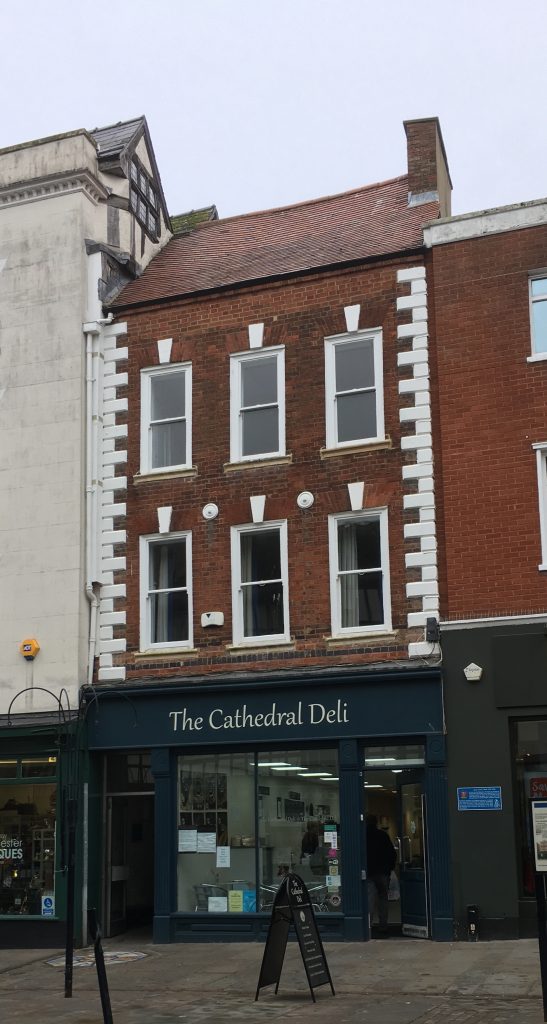When the earliest document
was created, in 1721, the property was owned by Nicholas Lane who was an
apothecary. It was in two parts, one under the auspices of the Mayor and
Burgesses of Gloucester, the other under the auspices of the Dean and Chapter
of Gloucester Cathedral. The former was
described as:
“All
that stable, summerhouse and garden situate and
being in the parish of Saint Mary de Grace in the city of Gloucester, then in
the tenure of the said Nicholas Lane or his under-tenant, consisting of all
that piece of ground extending from Grace Lane by the College wall to other the
land of the Mayor and Burgesses then in possession of Richard Elly, gent,
containing in length from Grace Lane aforesaid to a summerhouse newly built on
the west nineteen yards and in breadth four yards. And all that stable and building
thereon erected next to Grace Lane aforesaid. And after some part of the
summerhouse or building standing at the west end of the same piece of
ground containing in building from east to west two yards and an
half. And also all that other piece of ground extending in length
from the said summerhouse on the north to the lands of Mr Fletcher on the south
fourteen yards and in breadth two yards and an half having land of the Dean and
Chapter on the south and divided by a brick wall from other the lands of the
said Mayor and Burgesses on the west. Also all that part of a shop
on Maverdine Lane side with the building over it wherein Mr John Palmer
dwelleth containing in length from the street side to the north three yards and
two foot and in breadth one yard and one inch having Maverdine Lane on the
west side and the other part of the shop being College land on the east
together with a purpresture of half a yard broad the length of the shop next
the land together with all ways, passages,
and appurtenances to the said premises or any part thereof belonging or
in any wise appertaining. “
The second part of the
property was described thus:
“All that their shop with all the rooms thereupon built mentioned to
be situate lying and being on the parish of Grace Lane in the city of
Gloucester in a place there called the Mercerrow having the lands of the said
Dean and Chapter mentioned to be then in the possession James Wood, mercer, on
the east side, a lane or passage called Maudlin Lane on the west, the land of
Nicholas Lane on the north and the Kings Highway on the south and containing on
the forepart from east to west four yards and one foot and from north to south
seven yards and then in the possession of John Palmer, bookseller; And also all those their four stables
now converted into three tenements with two courts or gardens to the same
belonging situate, lying or being in the parish of Grace Lane in the city of
Gloucester aforesaid having lands then of Thomas Lugg, gent, on the south, the
lands of said Nicholas Lane on the north and west and the Kings Highway on the
east which said tenements do contain from east to west nine yards and an half
and from south to north next the Lane twelve yards and the courts or gardens do
contain from east to west ten yards and a quarter and from north to south nine
yards and a half and are mentioned to be in the possession of Robert Clarke,
Thomas Haines and the said Nicholas Lane; “
Nicholas Lane was born c.
1672 and married Hester Rodway in the 1690s. Over the next twenty years,
the couple had eleven children: Mary, Nicholas, Elizabeth, Kendrick, Sarah,
Hester, Lucina, Christianus, Charles, another Mary and
Eustace. Of these, Kendrick, Sarah, Christianus, Charles and
both Marys died young. Nicholas, junior, does not appear in any of the
documents relating to 24 Westgate Street; it is presumed he, as an adult, was
living a separate life from the rest of his family by the 1720s. His
sister, Elizabeth Lane, had married in 1714 to Richard Harding, a mercer from
Tetbury, whose name is prominent in the early documents.
Over the years, at least
from 1701 to 1717, Nicholas took on apprentices; Richard Yarnell, Thomas Hill,
Thomas Peynard, Thomas Scott, George Wilcox and Joseph Colesbourne. His
oldest son, Nicholas junior, also became an apothecary. But, by 1821,
Nicholas was not doing well in trade and was in deeply in debt. Fearful
that he would be sent to the debtor’s gaol in Gloucester Castle, Nicholas
transferred the property at 24 Westgate Street into the name of his wife and
those children still living at home, Hester, Lucina and Eustace, so that they
would still have a roof over their heads, should the worst occur. The
property was held in trust for them by two gentlemen; Richard Harding, his
son-in-law and John Rodway. John Rodway was also a mercer and, in 1723,
became Mayor of Gloucester. He was possibly a relative of Hester Lane,
Nicholas’ wife who, before their marriage, was Hester Rodway.
The financial situation did not improve for Nicholas Lane. In 1723, he took out a mortgage for £300 from Mary Clissold but, in 1728, he obviously had not paid all of the instalments on the mortgage, was arrested and put in gaol. After a while, the money was raised to pay his debts and he was released but the experience damaged his health and, later in 1728, he died. His wife, Hester, went to live with her daughter, Elizabeth Harding, in Tetbury, and died there in March 1732/3.

